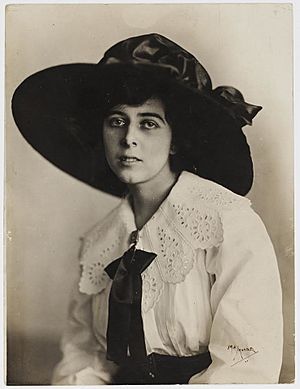Mirrie Hill facts for kids
Quick facts for kids
Mirrie Hill
|
|
|---|---|
 |
|
| Born | 1 December 1889 Randwick, New South Wales
|
| Died | 1 May 1986 St Leonards, New South Wales
|
| Occupation | Composer |
| Spouse(s) | Alfred Hill (married 1921–60) |
Mirrie Irma Hill (born Mirrie Solomon) was an amazing Australian composer. She was born on 1 December 1889 and lived until 1 May 1986. She wrote many different kinds of music, from big orchestral pieces to small songs for children.
Early Life and Musical Start
Mirrie Irma Jaffa Hill was born in 1889 in Randwick, a suburb of Sydney, Australia. She was the youngest of three children. Even when she was very young, Mirrie had a special talent for music. She could easily hear when notes didn't sound right together (this is called dissonance). She even used to leave the room if her aunt played music that sounded "off" to her!
Mirrie studied how to compose music with a teacher named Alfred Hill. He later became her husband. In 1914, when she was still quite young, her first big orchestral piece, Rhapsody for Piano and Orchestra, was performed in Sydney. She wanted to study music in Germany, but World War I made that impossible. So, she went to the New South Wales State Conservatorium of Music instead. She even won a special scholarship there!
A Career in Music
After finishing her studies in 1918, Mirrie Hill became a teacher at the Conservatorium. She taught students about harmony, counterpoint, and how to compose music. She worked there until 1944. Later, she also worked as an examiner for the Australian Music Examinations Board, helping to grade music students.
Mirrie became very interested in the music of Australia's First Peoples. An anthropologist named Charles P. Mountford asked her to write music for a film he was making about Aboriginal life. To help her, he gave her recordings of traditional Indigenous Australian songs. Mirrie used these recordings as inspiration for some of her own works, like her suite Three Aboriginal Dances and her Arnhem Land Symphony. She said that even though the Indigenous songs influenced her symphony, it wasn't meant to sound exactly like traditional Aboriginal music.
Mirrie Hill described her own music as unique and not too modern. She wrote over 500 pieces of music! These included music for orchestras, small groups of instruments (called chamber music), and even simple pieces for children. While she wrote some longer works, many of her published pieces were short, which is why she became known as a "miniaturist."
Personal Life
In 1921, Mirrie married her former teacher, Alfred Hill. He already had three children from a previous marriage, but Mirrie never had any children of her own. They built a home in Mosman, another Sydney suburb, and lived there for most of their lives.
Because Alfred Hill was a very famous composer, Mirrie's own music was sometimes overlooked. People described her as a shy and happy person. For much of her life, she focused on supporting her husband's career. However, after Alfred passed away, Mirrie's own works started to get more attention and recognition. In 1975, she was made a special lifetime member of the Fellowship of Australian Composers. In 1980, she received an OBE (Officer of the Most Excellent Order of the British Empire), which is a special award from the British King or Queen, recognizing her important contributions.
Selected Works
Mirrie Hill composed a wide variety of music, including pieces for orchestras, chamber groups, choirs, and solo instruments. She often used themes from Aboriginal culture and traditional Jewish melodies in her work.
Here are some of her well-known pieces:
- Rhapsody for Piano and Orchestra (1914)
- The Leafy Lanes of Kent (1950)
- Three Miniature Pieces for the Piano
- Three Aboriginal Dances (including Brolga, The Kunkarankara Women, and Nalda of the Echo) (1950)
- Arnhem Land symphony (1954)
Some of her works have been recorded and released on CDs, such as:
- Dance of the Wild Men – Early 20th Century Australian Piano Music
Other works by Mirrie Hill include:
- Meditation (1954)
- March of a Robot (1973)
- Dance of the Cunning Mouse (1973)
- My Bird Sings (1973)
- Merry Imp (1976)
- Come Summer (1969)
- Three Nice Mice (1970)
- Pipe Reel (1970)
- Child Fantasies (1935)
- Garden Sketches (1934)
- Mr. Roo (1948)
- Bell Birds (1952)
- The Dancing Fawn (1969)
- Party Tunes (1957)
- All In a Day (1950)
- Three Highland Tunes (1971)
- Dancing Feet (1950)
- Willow Wind (1973)
- Lost- my little black puppy: he scampers away (1949)
- For Hire (1949)
- Dreams (1942)
- Waltz (1942)

